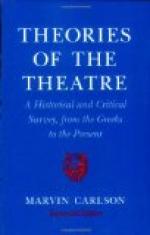If Sardou suffered through playing the sedulous ape to a histrionic artist, it is no less true that the same practice has been advantageous to M. Edmond Rostand. M. Rostand has shrewdly written for the greatest comedian of the recent generation; and Constant Coquelin was the making of him as a dramatist. The poet’s early pieces, like Les Romanesques, disclosed him as a master of preciosity, exquisitely lyrical, but lacking in the sterner stuff of drama. He seemed a new de Banville—dainty, dallying, and deft—a writer of witty and pretty verses—nothing more. Then it fell to his lot to devise an acting part for Coquelin, which in the compass of a single play should allow that great performer to sweep through the whole wide range of his varied and versatile accomplishment. With the figure of Coquelin before him, M. Rostand set earnestly to work. The result of his endeavor was the character of Cyrano de Bergerac, which is considered by many critics the richest acting part, save Hamlet, in the history of the theatre.
L’Aiglon was also devised under the immediate influence of the same actor. The genesis of this latter play is, I think, of peculiar interest to students of the drama; and I shall therefore relate it at some length. The facts were told by M. Coquelin himself to his friend Professor Brander Matthews, who has kindly permitted me to state them in this place. One evening, after the extraordinary success of Cyrano, M. Rostand met Coquelin at the Porte St. Martin and said, “You know, Coq, this is not the last part I want to write for you. Can’t you give me an idea to get me started—an idea for another character?” The actor thought for a moment, and then answered, “I’ve always wanted to play a vieux grognard du premier empire—un grenadier a grandes moustaches."... A grumpy grenadier of Napoleon’s army—a grenadier with sweeping moustaches—with this cue the dramatist set to work and gradually imagined the character of Flambeau. He soon saw that if the great Napoleon were to appear in the play he would dominate the action and steal the centre of the stage from the soldier-hero. He therefore decided to set the story after the Emperor’s death, in the time of the weak and vacillating Duc de Reichstadt. Flambeau, who had served the eagle, could now transfer his allegiance to the eaglet, and stand dominant with the memory of battles that had been. But after the dramatist had been at work upon the play for some time, he encountered the old difficulty in a new guise. At last he came in despair to Coquelin and said, “It isn’t your play, Coq; it can’t be; the young duke is running away with it, and I can’t stop him; Flambeau is but a secondary figure after all. What shall I do?” And Coquelin, who understood him, answered, “Take it to Sarah; she has just played Hamlet, and wants to do another boy.” So M. Rostand “took it to Sarah,” and finished up the duke with her in view, while in the background the figure of Flambeau scowled upon him over grandes moustaches—a true grognard indeed! Thus it happened that Coquelin never played the part of Flambeau until he came to New York with Mme. Sarah Bernhardt in the fall of 1900; and the grenadier conceived in the Porte St. Martin first saw the footlights in the Garden Theatre.




